#understanding how textiles are made
Text
youtube
Woman grows flax and makes linen from it!
(I was crying every time she complained about flax not growing in 3 months as it was expected, she planted it in late summer instead of early spring and expected it to grow in December T_T)
#flax#linen#making linen#growing your own clothing#this was such a fun and educational video for me#making of textiles#understanding how textiles are made#weaving#spinning#Youtube
75 notes
·
View notes
Text
everyone should attempt an artisan craft at some point in their life because it would cut down the number of comments questioning why handmade goods like ceramics or textile craft or woodworking are so expensive
and this is an unrealistic expectation, but I think the attempt should include seeing through to the end at least one "finished" item, no matter how clumsy or lumpy your first attempts might be. like to me, there's a huge difference in perspective between attempting to learn how to crochet or throw a pot for a few days, acknowledging that it's harder than it looks and giving up, versus committing to finishing that scarf or clay pot you started and working on it for weeks while you painstakingly learn from your mistakes and grow attached to your project while also simultaneously hating it.
once you finish the latter, your perspective changes from "why does this crocheted blanket cost $200" to "holy shit I can't believe they're charging $200 for this crocheted blanket instead of $2000" because you may have known crocheting is hard, you may have easily agreed with the idea that "handmade goods take time and effort" even before attempting a craft, but now you know firsthand the absolute time sink it takes to make things. like yeah dude, that one item took you 2 months to make and probably wasn't even an ultra complex item if it was the first thing you made, now imagine attaching an hourly wage to that time to calculate the cost (and this is ignoring every nuance of the artistic element and master crafters being able to work faster/charge higher because of their years and years of experience)
anyway this rant has been motivated by a comment I saw on someone else's ceramic post asking why a mug was $60 and they understand it's handmade but $60 just seems overpriced, and bro do you know how long ceramics take to make. that mug probably took at minimum 3 weeks between how long it takes to throw the mug, dry partially, trim the mug, dry fully, bisque fire, wait a day for the kiln to cool, sand and paint and glaze, glaze fire, wait a day for the kiln to cool, take product photography of the mug, write description and list the mug online for sale, im not even including the skill needed to complete all these steps without the mug literally exploding or collapsing while also making it an appealing piece of art, aaaaaaaaaaaaa
#$60 is overpriced my ass#if I priced my ceramics by the exact number of hours they took literally no one would buy anything#holding up a plate like oh yeah I started this in uhhhhhhhhhhh august and it finished in december#wrote this intending it to be a rant and delete post but im sending it out into the world
14K notes
·
View notes
Text
ive said this before but so much of what Retvrn Freaks glorify in early modern european art are just components inherent to the mediums being used at the time as opposed to like. an example of heightened skill that has been supposedly Lost in these degenerate times.... oil paint just looks like that. its very tonal and rich and even an artist with mediocre rendering skills will have their rendering skills improved by painting in oil. old oil paintings took years to complete not because the artists doing them were very skilled but because oil takes months to dry and they built up subtle washes over dried paint. tracing was also commonly utilized during that time period, and artists also often had small armies of apprentices who would do the hard work for them with no credit. these huge highly tonal oil paintings become significantly less impressive when you actually learn about their context.
#this isnt to like. diss or hate on oil painters or even all art made in europe during that time period#there are lots of great artists from that time period#but i also dont think that sort of art is more valuable than any other artistic movement#and i think posing these two very culturally european mediums as like the Pinnacle of art is stupid#another issue which isnt really to do with what im talking about here is like cultural ideals surrounding art...#if youre educated in a western tradition youre sort of encouraged to idolize realism and its associated artistic skills#eg: (anatomical accuracy - rendering skills - perspective)#and then favor mediums which lend better to those ideals. and then when you look at art from other cultural traditions#where the focus may have been on something different like color or symbol or narrative over realism you sort of see them as “lesser”#or theres the assumption that the artists who made those pieces were worse at art or unable to make highly realistic pieces#which is of course nonsense and also often racist (eg. colonizers in west africa assuming there must have been a greek colony#there because they found realistic statues and couldnt understand how people who currently made more stylized art could have made them)#but you even see this in popular assumption about european art pre-enlightenment too#like all those memes making fun of medieval manuscript faces. they drew like that because the narrative was more important than the realism#because the artists drawing them were basically illustrating bible stories#medium at hand also has a big hand to play here. art made for woodcut is gonna look different to art made for fabric#and oil paints arent uniquely european but they arent as widespread as clay or textile
0 notes
Text
Ngl, I think so many issues and so much drama could be avoided if people were able to recognize that they really aren't special
#ngl i've been watching a bunch a videos of textile crafters accusing each other of copying and im like#how can you truly believe this thing you made is so unique and special to you when crocheting and knitting has been around for 100s of year#escp when its like just four squares#this isn't just for crafting either#i do really think people would be happier recognizing that they really aren't unique#understanding that you are not uniquely evil or annoying#understanding you are not the first person to experience this thing#good or bad#understanding that the world doesn't revolve around you and not everything is about you because you are just another person#idk if any of this makes sense#but anywaus#anyways#my posts love
1 note
·
View note
Text
When I was an undergrad, I made a point of trying to sidetrack my supervisors as much as possible during supervisions, so that we could go off on a tangent and use up half the time discussing something barely related to my essay, and therefore have less time to dwell on its flaws.
(For those unfamiliar with the Cambridge supervision system, each week you're required to write an essay about a topic you probably knew nothing about before being handed the reading list, and then you spend an hour discussing it one-on-one, or in small groups depending on the subject, with your supervisor, who may be a random PhD student or may be the person who wrote half the reading list, depending on your luck.)
Once, I'd had a particularly bad week and had not written my essay about Scandinavian settlement in England, so I was having a more discussion-based supervision drawing on some bullet points I'd written. This would have been in my first term of first year, if I remember correctly. And we were talking about reasons why Vikings might settle rather than simply raiding, and my supervisor made some comment about them wanting "somewhere to wash their socks".
Sensing a potential avenue for distraction and also genuinely curious, I immediately asked, "Did Vikings wear socks?". My supervisor took the bait, and we passed the next ten minutes discussing a sock found preserved in York, of seemingly Scandinavian make, that would appear to answer that question in the affirmative. I remember very little else from that module, but nine years down the line, I remembered that there was a Scandinavian-style sock found in York.
Anyway, today I showed up to the department's graduate presentations (compulsory) and discovered that the first of the two talks was entirely about this sock. I was honestly so pleased. I now know several more things about this sock! I have some details to pad out my vague understanding that there was something distinctive about how it was made! I have been introduced to the complex question of "did the English wear socks or were they a Scandinavian fashion?"! (Answer: there is no definitive evidence for widespread early English sock-wearing, but textile evidence is complicated, so this may not be conclusive.)
This is probably not what most people took from the "England Before The Normans" paper, but frankly, I never was any good at keeping track of kings. I would rather learn about the socks. And today -- just as in that supervision nine years ago -- I did.
1K notes
·
View notes
Text
The Real Cost of the Fashion Industry

Atacama Desert, in Alto Hospicio, Iquique, Chile. (source)
The textile industry is destroying the world. The industry is wasting massive amounts of energy and materials, and polluting the air, the ground and the water supplies. It overwhelmingly exploits it's labour and extracts wealth from colonized countries, especially in Asia. I assume we all broadly understand this, but I think it's useful to have it all laid out in front of you to see the big picture, the core issues causing this destruction and find ways how to effectively move forward.
The concerning trend behind this ever-increasing devastation are shortening of trend cycles, lowering clothing prices and massive amount of wasted products. Still in year 2000 it was common for fashion brands to have two collections per year, while now e.g. Zara produces 24 collections and H&M produces 12-16 collections per year. Clothing prices have fallen (at leas in EU) 30% from 1996 to 2018 when adjusted to inflation, which has contributed to the 40% increase in clothing consumption per person between 1996 and 2012 (in EU). (source) As the revenue made by the clothing industry keep rising - from 2017 to 2021 they doubled (source) - falling prices can only be achieved with increasing worker exploitation and decreasing quality. I think the 36% degrees times clothing are used in average during the last 15 years (source) is a clear indication on the continuing drop in quality of clothing. Clothing production doubled between 2000 and 2015, while 30% of the clothes produced per year are never sold and are often burned instead (source), presumably to prevent the returns from falling due to oversupply.
These all factors are driving people to overconsume. While people in EU keep buying more clothes, they haven't used up to 50% of the clothes in their wardrobe for over a year (source). This overconsumption is only made much worse by the new type of hyper fast fashion companies like SHEIN and Temu, which are using addictive psychological tactics developed by social media companies (source 1, source 2). They are cranking up all those concerning trends I mentioned above.
Under the cut I will go through the statistics of the most significant effects of the industry on environment and people. I will warn you it will be bleak. This is not just a fast fashion problem, basically the whole industry is engaging in destructive practices leading to this damage. Clothing is one of those things that would be actually relatively easy to make without massive environmental and human cost, so while that makes the current state of the industry even more heinous, it also means there's hope and it's possible to fix things. In the end, I will be giving some suggestions for actions we could be doing right now to unfuck this mess.
Carbon emissions
The textile industry is responsible for roughly 10% of the global CO2 emissions, more than aviation and shipping industry combined. This is due to the massive supply chains and energy intensive production methods of fabrics. Most of it can be contributed to the fashion sector since around 60% of all the textile production is clothing. Polyester, a synthetic fiber made from oil which accounts for more than half of the fibers used in the textile industry, produces double the amount of carbon emissions than cotton, accounting for very large proportions of all the emissions by the industry. (source 1, source 2)
Worker exploitation
Majority of the textiles are produced in Asia. Some of the worst working conditions are in Bangladesh, one of the most important garment producers, and Pakistan. Here's an excerpt from EU Parliament's briefing document from 2014 after the catastrophic Rana Plaza disaster:
The customers of garment producers are most often global brands looking for low prices and tight production timeframes. They also make changes to product design, product volume, and production timeframes, and place last-minute orders without accepting increased costs or adjustments to delivery dates. The stresses of such policies usually fall on factory workers.
The wage exploitation is bleak. According to the 2015 documentary The True Cost less than 2% of all garment factory workers earned a living wage (source). Hourly wages are so low and the daily quotas so high, garment workers are often forced through conditions or threats and demand to work extra hours, which regularly leads to 10-12 hour work days (source) and at worst 16 hour workdays (source), often without days off. Sometimes factories won't compensate for extra hours, breaching regulations (source).
Long working hours, repetitive work, lack of breaks and high pressure leads to increased risks of injuries and accidents. Small and even major injuries are extremely common in the industry. A study in three factories in India found that 70% of the workers suffered from musculosceletal symptoms (source). Another qualitative study of female garment workers and factory doctors in Dhaka found that long hours led to eye strain, headaches, fatigue and weight loss in addition to muscular and back pains. According to the doctors interviewed, weight loss was common because the workers work such long hours without breaks, they didn't have enough time to eat properly. (source) Another study in 8 factories in India found that minor injuries were extremely common and caused by unergonomic work stations, poor organization in the work place and lack of safety gear, guidelines and training (source). Safety precautions too are often overlooked to cut corners, which periodically leads to factory accidents, like in 2023 lack of fire exists and fire extinguishers, and goods stacked beyond capacity led to a factory fire in Pakistan which injured dozens of workers (source) or like in 2022 dangerous factory site led to one dead worker and 9 injured workers (source).
Rana Plaza collapse in 2013 is the worst industrial accident in recent history. The factory building did not have proper permits and the factory owner blatantly ignored signs of danger (other businesses abandoned the building a day before the collapse), which led to deaths of 1 134 workers and injuries to 2 500 workers. The factory had or were at the time working for orders of at least Prada, Versace, Primark, Walmart, Zara, H&M, C&A, Mango, Benetton, the Children's Place, El Corte Inglés, Joe Fresh, Carrefour, Auchan, KiK, Loblaw, Bonmarche and Matalan. None of the brands were held legally accountable for the unsafe working conditions which they profited off of. Only 9 of the brands attended a meeting to agree on compensation for the victim's families. Walmart, Carrefour, Auchan, Mango and KiK refused to sight the agreement, it was only signed by Primark, Loblaw, Bonmarche and El Corte Ingles. The compension these companies provided was laughable though. Primemark demanded DNA evidence that they are relatives of one of the victims from these struggling families who had lost their often sole breadwinner for a meager sum of 200 USD (which doesn't even count for two months of living wage in Bangladesh (source)). This obviously proved to be extremely difficult for most families even though US government agreed to donate DNA kits. This is often said to be a turning point in working conditions in the industry, at least in Bangladesh, but while there's more oversight now, as we have seen, there's clearly still massive issues. (source 1, source 2)
One last major concern of working conditions in the industry I will mention is the Xinjiang raw cotton production, which is likely produced mainly with forced labour from Uighur concentration camps, aka slave labour of a suspected genocide. 90% of China's raw cotton production comes from Xinjiang (source). China is the second largest cotton producer in the world, after India, accounting 20% of the yearly global cotton production (source).
Pollution
Synthetic dyes, which synthetic fibers require, are the main cause of water pollution caused by the textile industry, which is estimated to account for 20% of global clean water pollution (source). This water pollution by the textile industry is suspected of causing a lot of health issues like digestive issues in the short term, and allergies, dermatitis, skin inflammation, tumors and human mutations in the long term. Toxins also effect fish and aquatic bacteria. Azo dyes, one of the major pollutants, can cause detrimental effects to aquatic ecosystems by decreasing photosynthetic activity of algae. Synthetic dyes and heavy metals also cause large amounts of soil pollution. Large amounts of heavy metals in soil, which occurs around factories that don't take proper environmental procautions, can cause anaemia, kidney failure, and cortical edoem in humans. That also causes changes in soil texture, decrease in soil microbial diversity and plant health, and changes in genetic structure of organisms growing in the soil. Textile factory waste water has been used for irrigation in Turkey, where other sources of water have been lacking, causing significant damage to the soil. (source)
Rayon produced through viscose process causes significant carbon disulphide and hydrogen sulphide pollution to the environment. CS2 causes cardiovascular, psychiatric, neuropsychological, endocrinal and reproductive disorders. Abortion rates among workers and their partners exposed to CS2 are reported to be significantly higher than in control groups. Many times higher amounts of sick days are reported for workers in spinning rooms of viscose fiber factories. China and India are largest producers of CS2 pollution, accounting respectively 65.74% and 11,11% of the global pollution, since they are also the major viscose producers. Emission of CS2 has increased significantly in India from 26.8 Gg in 2001 to 78.32 Gg in 2020. (source)
Waste
The textile industry is estimated to produce around 92 million tons of textile waste per year. As said before around 30% of the production is never sold and with shortening lifespans used the amount of used clothing that goes to waster is only increasing. This waste is large burned or thrown into landfills in poor countries. (source) H&M was accused in 2017 by investigative journalists of burning up to 12 tonnes of clothes per year themselves, including usable clothing, which they denied claiming they donated clothing they couldn't sell to charity instead (source). Most of the clothing donated to charity though is burned or dumbed to landfills (source).
Most of the waste clothing from rich countries like European countries, US, Australia and Canada are shipped to Chile (source) or African countries, mostly Ghana, but also Burkina Faso and Côte d'Ivoire (source). There's major second-hand fashion industries in these places, but most of the charity clothing is dumbed to landfills, because they are in such bad condition or the quality is too poor. Burning and filling landfills with synthetic fabrics with synthetic dyes causes major air, water and soil pollution. The second-hand clothing industry also suppresses any local clothing production as donated clothing is inherently more competitive than anything else, making these places economically reliant on dumbed clothing, which is destroying their environment and health, and prevents them from creating a more sustainable economy that would befit them more locally. This is not an accident, but required part of the clothing industry. Overproduction let's these companies tap on every new trend quickly, while not letting clothing the prices in rich countries drop so low it would hurt their profits. Production is cheaper than missing a trend.
Micro- and nanoplastics
There is massive amounts of micro- and nanoplastics in all of our environment. It's in our food, drinking water, even sea salt (source). Washing synthetic textiles accounts for roughly 35% of all microplastics released to the environment. It's estimated that it has caused 14 million tonnes of microplastics to accumulate into the bottom of the ocean. (source)
Microplastics build up into the intestines of animals (including humans), and have shown to probably cause cause DNA damage and altered organism behavior in aquatic fauna. Microplastics also contain a lot of the usual pollutants from textile industry like synthetic dyes and heavy metals, which absorb in higher quantities to tissues of animals through microplastics in the intestines. Studies have shown that the adverse effect are higher the longer the microplastics stay in the organism. The effects cause major risks to aquatic biodiversity. (source) The health effects of microplastics to humans are not well known, but studies have shown that they could have adverse effects on digestive, respiratory, endocrine, reproductive and immune systems. (source)
Microplastics degrade in the environment even further to nanoplastics. Nanoplastic being even smaller are found to enter blood circulation, get inside cells and cross the blood-brain barrier. In fishes they have been found to cause neurological damage. Nanoplastics are also in the air, and humans frequently breath them in. Study in office buildings found higher concentration of nanoplastics in indoor air than outdoor air. Inside the nanoplastics are likely caused mostly by synthetic household textiles, and outdoors mostly by car tires. (source) An association between nanoplastics and mitochondrial damage in human respiratory cells was found in a recent study. (source)
Micro and nano plastics are also extremely hard to remove from the environment, making it even more important that we reduce the amount of microplastics we produce as fast as possible.
What can we do?
This is a question that deserves it's own essays and articles written about it, but I will leave you with some action points. Reading about these very bleak realities can easily lead to overwhelming apathy, but we need to channel these horrors into actions. Whatever you do, do not fall into apathy. We don't have the luxury for that, we need to act. These are industry wide problems, that simply cannot be fixed by consumerism. Do not trust any clothing companies, even those who market themselves as ethical and responsible, always assume they are lying. Most of them are, even the so called "good ones". We need legislation. We cannot allow the industry to regulate itself, they will always take the easy way out and lie to their graves. I will for sure write more in dept about what we can do, but for now here's some actions to take, both political and individual ones.
Political actions
Let's start with political actions, since they will be the much more important ones. While we are trying to dismantle capitalism and neocolonialism (the roots of these issues), here's some things that we could do right now. These will be policies that we should be doing everywhere in the world, but especially rich countries, where most of the clothing consumption is taking place. Vote, speak to others, write to your representative, write opinion pieces to your local papers, engage with democracy.
Higher requirements of transparency. Right now product transparency in clothing is laughably low. In EU only the material make up and the origin country of the final product are required to be disclosed. Everything else is up to the company. Mandatory transparency is the only way we can force any positive changes in the production. The minimum of transparency should be: origin countries of the fibers and textiles in the product itself; mandatory reports of the lifecycle emissions; mandatory reports of whole chain of production. Right now the clothing companies make their chain of production intentionally complex, so they have plausible deniability when inevitably they are caught violating environmental or worker protection laws (source). They intentionally don't want to be able to track down their production chain. Forcing them to do so anyway would make it very expensive for them to keep up this unnecessarily complex production chain. These laws are most effective when put in place in large economies like EU or US.
Restrictions on the use of synthetic fibers. Honestly I think they should be banned entirely, since the amount of microplastics in our environment is already extremely distressing and the other environmental effects of synthetic fibers are also massive, but I know there are functions for which they are not easily replaced (though I think they can be replaces in those too, but that's a subject of another post), so we should start with restrictions. I'm not sure how they should be specifically made, I'm not a law expert, but they shouldn't be used in everyday textiles, where there are very easy and obvious other options.
Banning viscose. There are much better options for viscose method that don't cause massive health issues and environmental destruction where ever it's made, like Lyocell. There is absolutely no reason why viscose should be allowed to be sold anywhere.
Governmental support for local production by local businesses. Most of the issues could be much more easily solved and monitored if most clothing were not produced by massive global conglomerations, but rather by local businesses that produce locally. All clothing are made by hand, so centralizing production doesn't even give it advantage in effectiveness (only more profits for the few). Producing locally would make it much more easier to enforce regulations and it would reduce production chains, making production more effective, leaving more profits into the hands of the workers and reducing emissions from transportation. When the production is done by local businesses, the profits would stay in the producing country and they could be taxed and utilized to help the local communities. This would be helpful to do in both exploited and exploiter countries. When done in rich countries who exploit poorer ones, it would reduce the demand for exploitation. In poor countries this is not as easily done, since poor means they don't have money to give around, but maybe this could be a good cause to put some reparations from colonizers and global corporations, which they should pay.
Preventing strategic accounting between subsidiaries and parent companies. Corporate law is obviously not my area of expertise, but I know that allowing corporations to move around the accounting of profits and losses between subsidiaries and parent companies in roughly 1980s, was a major factor in creating this modern global capitalist system, where corporations can very easily manipulate their accounting to utilize tax heavens and avoid taxes where they actually operate, which is how they are upholding this terrible system and extracting the profits from the production countries. How specifically this would be done I can't tell because again I know shit about corporate law, so experts of that field should plan the specifics. Overall this would help deal with a lot of other problems than just the fashion industry. Again for it to be effective a large economic area like EU or US should do this.
Holding companies accountable for their whole chain of production. These companies should be dragged to court and made to answer for the crimes they are profiting of off. We should put fear back into them. This is possible. Victims of child slavery are already doing this for chocolate companies. If it's already not how law works everywhere, the laws should be changed so that the companies are responsible even if they didn't know, because it's their responsibility to find out and make sure they know. They should have been held accountable for the Rana Plaza disaster. Maybe they still could be. Sue the mother fuckers. They should be afraid of us.
Individual actions
I will stress that the previous section is much more important and that there's no need to feel guilty for individual actions. This is not the fault of the average consumer. Still we do need to change our relationship to fashion and consumption. While it's not our fault, one of the ways this system is perpetuated, is by the consumerist propaganda by fashion industry. And it is easier to change our own habits than to change the industry, even if our own habits have little impact. So these are quite easy things we all could do as we are trying to do bigger change to gain some sense of control and keep us from falling to apathy.
Consume less. Better consumption will not save us, since consumption itself is the problem. We consume too much clothing. Don't make impulse purchases. Consider carefully weather you actually need something or if you really really want it. Even only buying second-hand still fuels the industry, so while it's better than buying new, it's still better to not buy.
Take proper care of your clothing. Learn how to properly wash your clothing. There's a lot of internet resources for that. Never wash your wool textiles in washing machine, even if the textile's official instructions allow it. Instead air them regularly, rinse them in cool water if they still smell after airing and wash stains with water or small amount of (wool) detergent. Never use fabric softener! It damages the fabrics, prevents them from properly getting clean and is environmentally damaging. Instead use laundry vinegar for making textiles softer or removing bad smells. (You can easily make laundry vinegar yourself too from white vinegar and water (and essential oils, if you want to add a scent to it) which is much cheaper.) Learn how to take care of your leather products. Most leather can be kept in very good condition for a very long time by occasional waxing with beeswax.
Use the services of dressmakers and shoemakers. Take your broken clothing or clothing which doesn't fit anymore to your local dressmaker and ask them if they can do something about it. Take your broken and worn leather products to your local shoemaker too. Usually it doesn't cost much to get something fixed or refitted and these expert usually have ways to fix things you couldn't even think of. So even if the situation with your clothing or accessory seems desperate, still show it to the dressmaker or shoemaker.
If it's extremely cheap, don't buy it. Remember that every clothing is handmade. Only a small fraction of the cost of the clothing will be paying the wages of the person who made it with their hands. If a shirt costs 5 euros (c. 5,39 USD), it's sewer was only payed mere cents for sewing it. I'm not a quick sewer and it takes me roughly 1-2 hours to cut, prepare and sew a simple shirt, so I'm guessing it would take around half an hour to do all that for a factory worker on a crunch, at the very least 15 minutes. So the hourly pay would still be ridiculously low. However, as I said before, the fact that the workers in clothing factories get criminally low pay is not the fault of the consumer, so if you need a clothing item, and you don't have money to buy anything else than something very cheep, don't feel guilty. And anyway expensive clothing in no way necessarily means reasonable pay or ethical working conditions, cheep clothing just guarantee them.
Learn to recognize higher quality. In addition to exploitation, low price also means low quality, but again high price doesn't guarantee high quality. High quality allows you to buy less, so even if it's not as cheep as low quality, if you can afford it, when you need it, it will be cheaper in long run, and allows you to consume less. Check the materials. Natural fibers are your friends. Do not buy plastic, if it's possible to avoid. Avoid household textiles from synthetic fibers. Avoid textiles with small amounts of spandex to give it stretch, it will shorten the lifespan of the clothing significantly as the spandex quickly wears down and the clothing looses it's shape. Also avoid clothing with rubber bands. They also loose their elasticity very quickly. In some types of clothing (sport wear, underwear) these are basically impossible to avoid, but in many other cases it's entirely possible.
Buy from artisans and local producers, if you can. As said better consumption won't fix this, but supporting artisans and your local producers could help keep them afloat, which in small ways helps create an alternative to the exploitative global corporations. With artisans especially you know the money goes to the one who did the labour and buying locally means less middlemen to take their cut. More generally buy rather from businesses that are located to the same country where the production is, even if it's not local to you. A local business doesn't necessarily produce locally.
Develop your own taste. If you care about fashion and style, it's easy to fall victim to the fashion industry's marketing and trend cycles. That's why I think it's important to develop your personal sense of style and preferences. Pay attention at what type of clothes are comfortable to you. Go through your wardrobe and track for a while which clothing you use most and which least. Understanding your own preferences helps you avoid impulse buying.
Consider learning basics of sewing. Not everyone has the time or interest for this, but if you in anyway might have a bit of both, I suggest learning some very simple and basic mending and reattaching a button.
Further reading on this blog: How to see through the greenwashing propaganda of the fashion industry - Case study 1: Shein
Bibliography
Academic sources
An overview of the contribution of the textiles sector to climate change, 2022, L. F. Walter et al., Frontiers in Environmental Science
How common are aches and pains among garment factory workers? A work-related musculoskeletal disorder assessment study in three factories of south 24 Parganas district, West Bengal, 2021, Arkaprovo Pal et al., J Family Med Prim Care
Sewing shirts with injured fingers and tears: exploring the experience of female garment workers health problems in Bangladesh, 2019, Akhter, S., Rutherford, S. & Chu, C., BMC Int Health Hum Rights
Occupation Related Accidents in Selected Garment Industries in Bangalore City, 2006, Calvin, Sam & Joseph, Bobby, Indian Journal of Community Medicine
A Review on Textile and Clothing Industry Impacts on The Environment, 2022, Nur Farzanah Binti Norarmi et al., International Journal of Academic Research in Business and Social Sciences
Carbon disulphide and hydrogen sulphide emissions from viscose fibre manufacturing industry: A case study in India, 2022, Deepanjan Majumdar et al., Atmospheric Environment: X
Microplastics Pollution: A Brief Review of Its Source and Abundance in Different Aquatic Ecosystems, 2023, Asifa Ashrafy et al., Journal of Hazardous Materials Advances
Health Effects of Microplastic Exposures: Current Issues and Perspectives in South Korea, 2023, Yongjin Lee et al., Yonsei Medical Journal
Nanoplastics and Human Health: Hazard Identification and Biointerface, 2022, Hanpeng Lai, Xing Liu, and Man Qu, Nanomaterials
Other sources
The impact of textile production and waste on the environment (infographics), 2020, EU
Chile’s desert dumping ground for fast fashion leftovers, 2021, AlJazeera
Fashion - Worldwide, 2022 (updated 2024), Statista
Fashion Industry Waste Statistics & Facts 2023, James Evans, Sustainable Ninja (magazine)
Everything You Need to Know About Waste in the Fashion Industry, 2024, Solene Rauturier, Good on You (magazine)
Textiles and the environment, 2022, Nikolina Šajn, European Parliamentary Research Service
Help! I'm addicted to secondhand shopping apps, 2023, Alice Crossley, Cosmopolitan
Addictive, absurdly cheap and controversial: the rise of China’s Temu app, 2023, Helen Davidson, Guardian
Workers' conditions in the textile and clothing sector: just an Asian affair? - Issues at stake after the Rana Plaza tragedy, 2014, Enrico D'Ambrogio, European Parliamentary Research Service
State of The Industry: Lowest Wages to Living Wages, The Lowest Wage Challenge (Industry affiliated campaign)
Fast Fashion Getting Faster: A Look at the Unethical Labor Practices Sustaining a Growing Industry, 2021, Emma Ross, International Law and Policy Brief (George Washington University Law School)
Dozens injured in Pakistan garment factory collapse and fire, 2023, Hannah Abdulla, Just Style (news media)
India: Multiple factory accidents raise concerns over health & safety in the garment industry, campaigners call for freedom of association in factories to ‘stave off’ accidents, 2022, Jasmin Malik Chua, Business & Human Rights Resource Center
Minimum Wage Level for Garment Workers in the World, 2020, Sheng Lu, FASH455 Global Apparel & Textile Trade and Sourcing (University of Delaware)
Rana Plaza collapse, Wikipedia
Buyers’ compensation for Rana Plaza victims far from reality, 2013, Ibrahim Hossain Ovi, Dhaka Tribune (news media)
World cotton production statistics, updated 2024, The World Counts
Dead white man’s clothes, 2021, Linton Besser, ABC News
#fashion#fashion industry#sustainability#sustainable fashion#sustainable clothing#environment#climate change#i will be continuing the series of how to see through fashion industry propaganda at some point#i just felt compelled to write this because i feel like people so often miss the forest for the trees in this conversation
362 notes
·
View notes
Text
fiber art adventures in egypt
I recently got back from a trip to Egypt & finally got around to organizing some pictures to share. One of the things I was most excited about was seeing what I could find on fiber arts and textiles.
Dropping everything under a read more, 'cause this will be a long post haha
first visit: the National Museum of Egyptian Civilization (NMEC)
At the time of visiting, they had a special textiles exhibit. It covered Pharonic Egypt all the way up to modern times, although I only had time to check out the dynastic & a bit of the Coptic portion of the exhibit (which was what I was really hoping to see anyways)
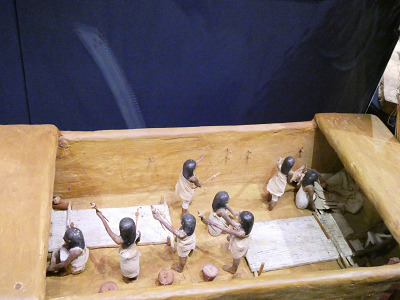

Was super excited to see this diorama in person. I knew about it but had never seen good pictures of it. From the little I've seen of ancient Egyptian spinning, spinning with two spindles seems to be the norm rather than a master technique? It also shows up in tomb art, which the exhibit also shared:

They also used a different fiber preparation (splicing to create a rove of fiber, no traditional drafting to my understanding) so that probably made a difference? Regardless I really want to see if I can replicate the technique, especially because their spindles look so similar to modern spindles??

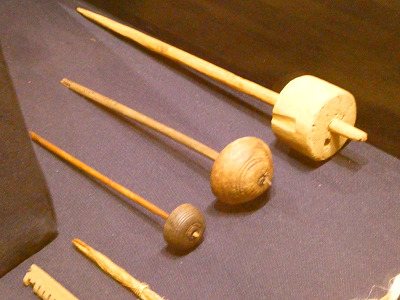
I took so many pictures of spindles, guys, and I fully intend to either have a few replicas made or to learn to make some myself. Also, although they were unlabeled... I'm pretty sure those are beaters for weaving? That was a bit of a trend with this trip, so much stuff was unlabeled :( I would've killed to at least get some date estimates for some of the stuff they had on display. I was nerding out in here though, and my family took a few pictures of how excited I was getting. A bit embarrassing, but eh haha
The exhibit also had a section on natural dyes used with a fun visual;
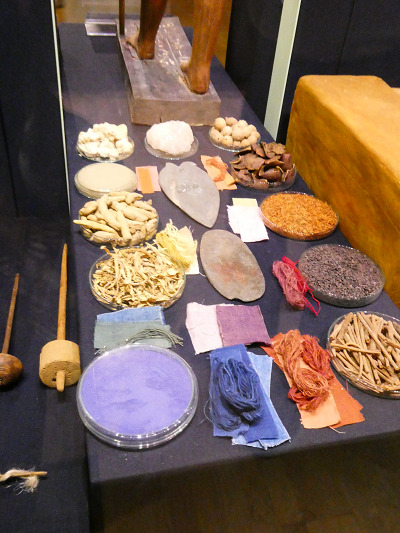
There was several diagrams specifically describing each dye source, but in the interest of not overloading on pictures I'll just list them out. For blues; woad, Yellows; turmeric, safflower, saffron, or yellow ochre; reds; madder, henna, pomegranate, and kermes. I originally thought kermes was another way to say cochineal, but it only seems to be distantly related.
next visit: Ramses Wissa Wassef Art Center
A small art center dedicated to hand-weaving wool and cotton tapestries. All of their work was museum quality & awe inspiring!!
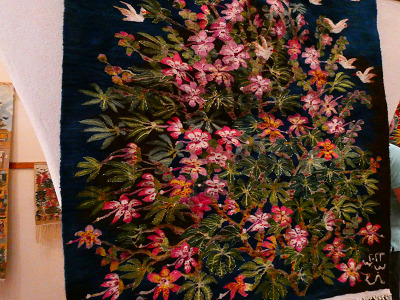


Was even invited to their back rooms to watch a few of their weavers working; no I don't have room to put a room-sized loom anywhere but heck do I want one now

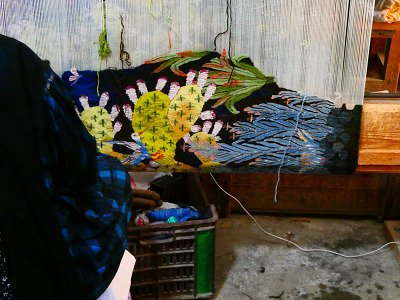
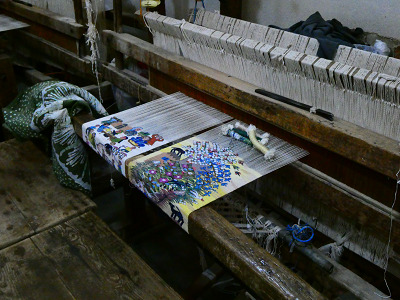
Our guide that took us through talked a bit about the natural dyes they use (all of their dyes are dyed in house with what they grow in their dye garden!!!) and got excited to hear I was also interested in natural dyes! He seemed a bit disappointed I'd never worked with indigo and. while indigo scares me, I'll take it as a sign that maybe I should try some time this year haha.
final visit; the Egyptian Museum
we really had to rush through this one which was a huge shame because it's packed full of artifacts. Also, the lighting in there is atrocious, so apologies for the not great pictures ahead.
They had a fascinating display of textile tools, more than what the NMEC had;



(Hand for size reference) I want all of these spindles! So badly! But a few of them look so much like a few of the spindles I own already?? A few of them had a spiraling notch, that's so cool? But also, what's going on with the one with two whorls? I have no idea. I'm fascinated.
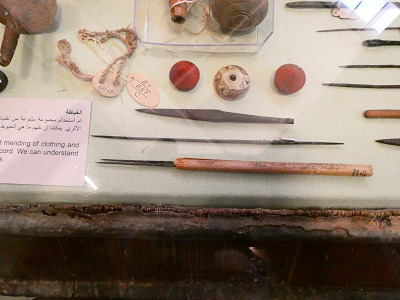

Look at these whorls!! Although again, I'm a bit confused; the lack of labeling strikes again. Unsure why some of these "whorls" have two holes, or what the metal object with the wooden handle is. The display implies sewing needles, and some of them do look like it, but others.... really don't look like sewing needles. I'm absolutely enchanted by this little whorl though. I think it has birds on it?
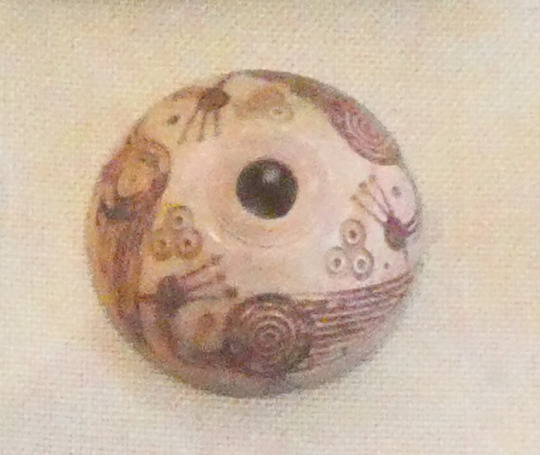

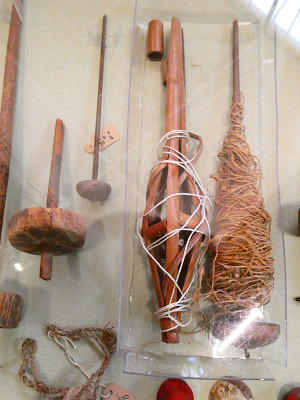
More objects that I'm baffled by- the signage doesn't really indicate what some of this stuff is, if it's even known. Also confused by the object wrapped in white string in the right pic; it looks like a distaff but to the best of my knowledge the (ancient at least) Egyptians didn't use distaffs. It probably popped up in later times and was put in this display since it was still relevant, but I'm still not sure.
I have so many more pictures & thoughts but I'll save those for more specific future projects. I've been doing research outside this trip on ancient Egyptian spinning techniques and desperately want to go deeper into that, this trip just solidified how excited it makes me. If you made it all the way through this, many thanks for reading!
Bonus; look at this ancient linen 🥺

#hand spinning#archaeology#extant artifact#weaving#fiber arts#long post#letters from skylark#sorry for the overall low quality images in this post. Got a new camera and wasn't the best at using it this trip#also the raw image files were huge so I heavily downsized them to make sure this post wasn't a beast to load#would be happy to share the raw images if desired though
249 notes
·
View notes
Text
Man, there is a huge bias in the way that hobby fibercrafters approach and think about textiles—and I say that as a hobby fibercrafter myself! See, weaving has a high barrier to entry relative to knitting, crochet, spinning—even embroidery or sewing, these days, as the sewing machine automated much of the tedium of the craft. All of those crafts require a lot less in terms of startup costs to the hobby crafter than the machinery of a loom does.
But... look, if you want to understand mass produced textiles or textiles in any historical context, you have to understand weaving. If you want to understand how most of the cloth that people wear is made, you have to understand weaving, because weaving is the oldest art for mass producing cloth that can then be turned into garments.
Spinning is also very important, of course. Spinning is how you get the thread that you can turn into cloth any number of ways. Historically speaking, though, the most common way that thread or yarn becomes cloth is inarguably weaving. More to the point, weaving is also a historical center of industry and labor organizing. Ironically enough for the argument about how no one asked a woman, the industrialization of weaving is actually an interesting early case example of men organizing to push women out of a newly profitable position.
Besides that, knitting and crocheting in particular are incredibly modern crafts. Most modern knitting as we would understand the craft is shaped by the inventions of Elizabeth Zimmerman, and even things like the circular knitting needle date back only to the past century. Historically speaking, the great innovation of knitting as a tool for fiber craft is the ability to construct garments for small, odd shapes that can stretch and grip: stockings, gloves, underwear. Even that great innovation, the knit sweater, is an artifact of the 1850s—and the familiar cable knit sweaters of the Aran Isles are even newer than that. Crochet is even younger: the entire craft originated in the 1820s as far as anyone can document.
None of that is any shade on anyone. Like I said, I knit; that's the locus of my personal interest in textiles. I just think that textile history is neat, but if you're going to make big pronouncements about the historical development of textiles, it's important to think about what changed about the technology of textile production in the most common ways of turning raw fiber into cloth—and you cannot stop at the level of understanding how to make thread or yarn, because the properties of the cloth are always going to be an artifact of the construction of the cloth.
That's technology, baby! It's literally weavecraft. But it's not obvious that weaving is missing from the bounds of a person's experience with textile manipulation until and unless they're trying to understand and work with a wide range of fabric types—and when you can quite reasonably go from raw fiber to a finished garment using modern popular craft techniques that don't rely on anything that appears difficult for a medieval craftsman to make, it's easy to forget the role of weaving in the creation of cloth as a finished product.
I suppose the point I am making is: think deeply about what your own areas of expertise are not bringing to your understanding of history. It's easier to miss things you'd think.
225 notes
·
View notes
Text
it would be hilarious if Cybertronians just could not adapt to dealing with sentient organics at all and perpetually kept seeing most humans as more or less pets or at least animals (technically true) even if they actively tried not to
I mean, there are also horrific implications of that, but also a lot of funny ones
this might be funniest in TFP, actually
just like the constant talking about Miko right in front of her would be so fucking funny but also awful but in a funny way, mostly
probably because Miko would lean into it. like hell yeah I'm an attack dog and Jack is just like please don't encourage this
Bulkhead is like oh shit my human turbofox thing is loud, is it broken??
imagine how Season 1 Ratchet would be about this, holy shit lol
"Ratchet, she makes a lot of noise..."
"I thought you liked noise, Bulkhead. At the very least, organics tend to have a limited energy output, you won't have to listen to it for long."
"I don't think she likes the habitat we made for them. I think she's biting the, uh, textiles components."
"Hmmph. I think I did a fine job building a safe enclave for them, thank you! Especially with our limited materials, which we shouldn't be wasting on random organic lifeforms, by the way...!"
fast forward a little and Ratchet has a special tiny habitat area built solely for Raf, lmao
like "I'm keeping this one away from yours, it's smaller and can get hurt easier. And it appreciates the monitors I put in there, look at it. It's doing math. This is the smartest organic on this dirt hovel of a planet."
the humans constantly try to get the bots to talk to them more and gradually the bots respect and understand their sentience a little better, sure
but mostly they would never take Fowler all that seriously either, like lol look, organics think they have a functioning government, even mechanical lifeforms have never pulled that off
idk it's fucked up but also very funny to me
#tfp#transformers prime#maccadam#maccadams#tfp bulkhead#tfp ratchet#tfp raf#tfp miko#tfp jack#tfp fowler
629 notes
·
View notes
Text
I'm not mad I'm just disappointed because if you spent two seconds to think about how fur and leather alone has deep ties to human culture and our understanding and appreciation of the natural world it's honestly really beautiful and just feels so strange to me that people who say they love nature want to divorce themselves from it.
Like yes, capitalism bad. I don't agree with the way that animals are treated as products to the point where blatant animal cruelty is excused by mega corporations. I want places like that to be held accountable and made to follow higher welfare standards for the animals they raise and the underpaid employees out there working in sometimes awful and very unsafe conditions.
But if you're simultaneously ignoring the culture of African leathermaking or the beautiful leather and wool textiles crafted by Indigenous artisans or the ways that ancient humans appreciated the animals they killed for meat and clothing by telling stories and making art depicted on the skins of the animals they took, that's what bothers me.
So many people are willing to just attack vulnerable communities instead of learning about thier culture and how animal products were used traditionally and today. There are better ways to raise animals for products sustainably and humanely and many of these communities have spoken very loudly about it but are yelled over by people who just want to be right or don't want to listen or just don't care.
So yes, I will continue to speak my mind and educate myself because if nothing else I wanna be the start of the change I wanna see in the world. I love animals and I love learning the history of humans and our relationships to animals. I want to be able to appreciate them in the ways we always have. With respect to the natural world and understanding that we're also a part of it.
#jackal's journal#ok I'm done#I can't sleep so I'm rambling but#stop assuming your way is the only way#or that people who defend the use of animal products are just automatically siding with the devil#ya'll don't even know how hard it is to research my own cultural background because of this#like given I had the time and resources I would LOVE to study African-American leathermaking and use of animal products#but so many businesses were wiped from existence or bought up or shut down#lemme stop before I get too passionate in my own damn tags#I just got feelings
1K notes
·
View notes
Note
Could I request headcanons of Ruggie, Trey, and Jamil with an s/o who's good at textile design 🪡 (sewing, knitting, embroidery, etc)?
Of course!! Also, did you guys know that Crewel’s name isn’t just a play on “Cruel”, it’s also a type of embroidery?
Ruggie, Trey, and Jamil + S/O that’s good at textile design!
Ruggie Bucchi
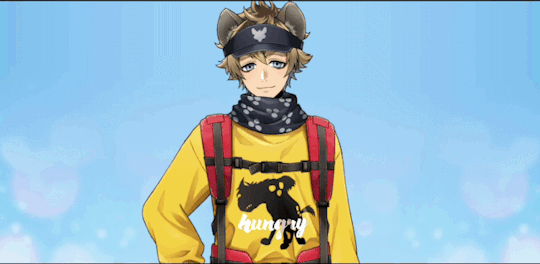
Ruggie won’t say it out loud, but he really does like it when you give him things you embroidered. It makes him feel special; knowing that you went out of your way to give him something handmade.
He is definitely flaunting your work to anyone willing to listen. And some who aren’t. It’s gotten to the point where even Leona knows about your skills.
The best way to get him to practically swoon is by patching up some of his old clothes without being asked. Something about you noticing it and going out of your way for him makes the poor guy’s heart flutter.
He’s gonna try to get you to make a business out of your skills. There’s definitely a market out there for custom embroidery, and you two could definitely get in on it!
“Hey, just think about it. You could make a killing doing this for the students. They’d pay a stupid amount of cash to make them stand out a little!”
Trey Clover

Trey enjoys watching you work on your projects. He loves how focused you are and how much you love doing it.
He’d never ask you to, he knows how stressful it is to be a student here already, but he’d love it if you put some of your own touches on his clothing.
Finds himself getting inspired by your work while thinking of how to decorate his cakes. Obviously frosting and fondant are very different from string, so it isn’t a perfect replica, but he does get pretty close to it.
Going back to an earlier point, if you embroider something small like roses or really anything you’d like, he would spend forever admiring each and every detail.
“How you can add so much detail on such a small space is something I can never understand. It’s really incredible.”
Jamil Viper

While I’m sure Jamil has some skill with a needle, it’s mostly just to stitch up some holes quickly. He honestly doesn’t think about it until he sees what you’re able to do with it.
He’s very impressed with your patience while sewing, he knows that he’d get frustrated if he attempted something similar.
If you give him something you made yourself he’d treat it like it was made of gold. He hardly lets anyone touch it, partly out of fear of damaging it and partly out of his own pride.
He enjoys watching you plan out your next projects, helping you choose the colors and designs. If you ask nicely, he might model some of them for you.
“Does this look how you pictured it? It does suit me quite well, I must admit.”
#twisted wonderland imagines#twisted wonderland x reader#twst x reader#twst imagines#twsited wonderland#twst ruggie#ruggie bucchi x reader#ruggie bucchi#trey clover x reader#twst trey#trey clover#jamil viper#twst jamil#jamil viper x reader
229 notes
·
View notes
Text
Alva Relationship HCs: SFW and NSFW
As always, NSFW under the cut. Minors please dni with this post

SFW
-Alva’s first love is and will always be his work. That’s not to say he doesn’t love his partner—he does! But he can’t be with someone who expects to be chosen over his only passion at any given moment. When Alva has lost people in the past, his work is what got him through, and if you ever leave it will be the same. He can’t let go of that. His partner needs to be someone who understands that Alva’s relationship with his research is steeped in emotional dependency, and can work with him on the amount of time he’d like to dedicate to it. That said, he’s generally pretty good about sharing his work space as long as you can respect his boundaries about touching certain things, and he always respects plans you’ve made.
-Alva’s love languages are Gift Giving and Physical Touch (giving), and Words of Affirmation and Quality Time (receiving). His chivalry skyrockets for his partner, who he sometimes feels bad for not spending as much time on as his work. He tries to makeup for it by showing his love with ‘little’ things. He’s the type of man to leave you flowers often, and little trinkets he buys or makes for you, with a little card to express some sweet sentiment. He also likes to have a hand on you when you’re nearby, either holding your own hand, or the small of your back. He gives forehead kisses a lot (he’s mf tall so this is easiest for him) and loves to pinch little pieces of his s/o’s clothes to rub between his fingers for comfort and textile stimulation. It’s pretty cute how you’ll end up with random little worn spots on your clothes. For receiving, Alva just likes to be reminded verbally that you love him, care for him. The quality time is a bit odd given that sometimes he refuses it—but even when that’s the case he just really likes when his s/o asks if they can hang around with him. There’s no such thing as asking Alva too often; he’s never annoyed by it.
-Alva also appreciates being told he’s attractive. It’s not something he mentions—mostly because it’s rarely relevant—but he does have some sensitivity to the state of his post-resurrection body. Scars abound under his clothes and bandages, his eyes are dark and sunken, his skin always cold. But he’s similar to Luca in that he takes anything his partner says for face value. So if you like how he looks, it’s enough for him to be told.
-He’s not an especially spontaneous person, let alone lover. The biggest surprise you’ll get from him is a random night of fine dining and dancing to records, preferably at home. Call him boring, but he likes intimacy and bonding without others around to gawk at it. You’re one of the few people he can enjoy for long periods, and the presence of others would just be a drain on him. But if you express a desire for some specific date plan, say ice skating or going to an orchestra, Alva will make that happen too.
-Alva is neither specifically protective nor possessive. He’s available to offer comfort whenever you need it, but he pretty much trusts you to handle your own affairs and ask for help if it’s needed. If you do ask for help, or something serious happens, Alva is very direct about the problem. He wants it gone as soon as possible. For a person, he will go speak to them immediately. He’s not the most intimidating Hunter, but the electricity he controls is usually enough to dissuade someone from continuing to be a problem.
NSFW
-Alva has a low libido. He’s only in the mood for proper sex occasionally, like once every few weeks, maybe. But he’s a service top and usually willing to provide something else to satisfy his partner when they’re in the mood. His go-to is oral, and he’s quite good at it. Alva gives like he works: meticulously and thoroughly. You can expect many of your sessions to be spend with you laid out on his desk, entirely naked, while Alva sits in his chair and licks at you slowly like he’s indulging in a snack. (I mean, he is lol) He’s also decent with his hands. He has those nice, long, slender fingers. If you have an exceptionally high libido, however, he will have trouble keeping up and may occaisonally ask you to just indulge in some toys.
-Alva is not a fan of “quickies”—or quick anything, really. Alva is not a man who appreciates being rushed and does not like to cut corners or take the easy way out of anything. If you want pleasure from him, he wants you to slow down and enjoy every moment of I instead of just rushing headlong to the finish. Let him take his time with you.
-Alva is not facially expressive most of the time, but sex is one of the few exceptions. His endurance is better now than is was when he was alive, but it’s still only slightly above average. When he’s having proper sex, he gets visibly wrecked. He’s on the quiet side, however, even when he’s at his most pleasured.
-He’s also not particularly kinky, but he does like seeing his s/o all dolled up, dressed up like you’re going to a formal party, maybe with some nice lace underneath it all. He enjoys the process of taking it all off, slowly unwrapping his present, admiring the clothes and the effort and the treat underneath. He’d also enjoy being given the controller for a remote toy you’re using. He doesn’t want you in public while under the influence of it, mind you. So just sit your pretty self down in that chair over in the corner of his lab and enjoy. Beware: he’s just cheeky enough to tease you with it a little.
-Like Luca, he can provide some shocks for you, if that’s your thing. Unlike Luca, it’s entirely controlled and he won’t be doing it accidentally.
115 notes
·
View notes
Text


La Pedrera. Photos from Ajuntament de Barcelona and La Pedrera.
Nowadays, la Pedrera is one of the most famous building in Barcelona, Catalonia. It's one of the most emblematic buildings in the Catalan Modernism style, and has been declared part of the UNESCO World Heritage Site "Works of Antoni Gaudí".
But it hasn't always been recognised as good architecture, all the opposite! In fact, take a look at its name: it's technically called Casa Milà (house of the Milà family), but locals always call it "la Pedrera", which means "the quarry" in the Catalan language. When it was built, in 1910, Barcelonians thought it looked like an ugly piece of stone-y quarry mountain in the middle of the city.
But that's not the only thing that they thought it looked like. Let's see some parodies that were published at the time:

In 1909, the popular magazine Cu-Cut! published this vignette of a mother and a son walking in front of the house, when the child asks his mom "was there also an earthquake here?". This is a reference to an earthquake that happened in Sicily the previous month, and to the house's bendy shapes that look like it was shaken.

In 1925, the children's magazine En Patufet also joined in, with a vignette where the owner realises he can't hang up curtains* on this windows.
*Note: I'm using the translation "curtains" as a simplification so that English speakers without a detailed knowledge of Catalan culture can understand the joke. The vignette actually uses the word "domàs", meaning a decorative textile that is hanged from balconies during holidays.

In 1910, Cu-cut! compared it to a mona, the cake that Catalans eat on Easter Monday, by drawing a vignette where a child says "Daddy, daddy, I want a mona as big as this one!".

Three times did the magazine El Diluvio mock this building.
First, in 1910, they called it a "Medieval architecture model, between burrow and burial, that I don't quite dislike". It described its future in the following way: "the round gaps in the façade have become dark holes where all kinds of vermin come in and out: crocodiles and rats, but also snakes, hedgehogs, owls, sea monsters... Two undulating lines wrap up the building, which stands in front of an absolutely black sky. Above it, in the rooftop, the chimneys, the air vents and the stairs' endings have stopped being whipped cream mountains to become sinister piles of skulls."
In 1911, El Diluvio striked again, comparing the building's cast iron handrails to a fish stand. Their illustration had Casa Milà with a sign saying "cod entrails sold here!".
And lastly, it made fun of the controversial statue of Our Lady of the Rosary that was supposed to go on top. The Milà family in the end decided not to place the statue (some say because they didn't like how the sculptor made it, some say it's because they were scared of having a religious symbol after the 1909 anti-clerical riots) but the architect Gaudí, who was a very religious man, insisted on having it. This caused the Milàs and Gaudí to argue, which the magazine represents with a caricature of Mr. Milà wearing a Tarzan-like loincloth and branding a whip fighting against Gaudí wearing a pith helmet, grabbing him by the hair and hitting him with a hammer. The text under the image translates to "Will the Virgin Mary stand on top of the peculiar monument? Who will win, Gaudí or Milà?".
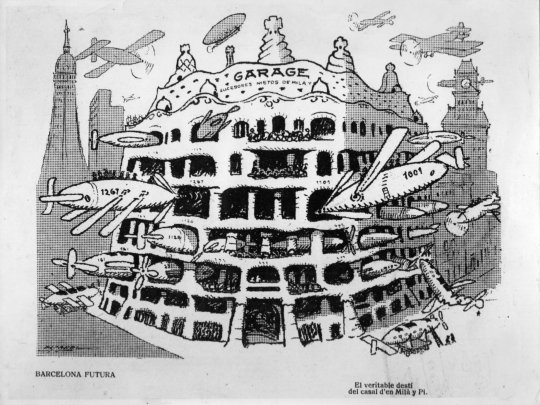
In 1912, the popular magazine L'Esquella de la Torratxa imagined that this extravagant futuristic building could only be a garage for parking airship and air-planes. This satirical drawing is titled "Future Barcelona. The true destiny of the Milà and Pi house". (Milà and Pi were the owners of this building).
The text that accompanied this illustration wondered if this building is the Wagnerian Valhalla, an anti-aircraft defense for the Moroccan War, or a hangar for zeppelins.
What do you think? Was the banter justified?
#la pedrera#casa milà#barcelona#catalunya#història#arquitectura#arts#history#architecture#antoni gaudí#gaudí#unesco world heritage#world heritage#historical#history tag#art history#art#modernisme#travel
177 notes
·
View notes
Photo
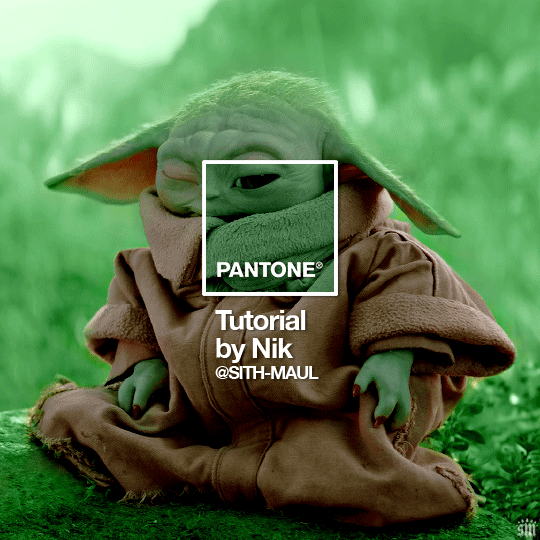
HOW TO: Make a Pantone “Color of the Year” Gif
A few people have asked about my Pantone sets which use the “Color of the Year” swatch design. So, here’s a full tutorial with a downloadable template of my exact overlay! Disclaimer: This tutorial assumes you have a basic understanding of gif-making in Photoshop.
PHASE 1: PICKING A SCENE + PANTONE COLOR(S)
I’m starting with this because it’s crucial for planning your gifset as well as making sure the execution is smooth sailing. The steps in this phase won’t necessarily be literal steps but some tips for how I usually go about making a Pantone set:
1.1 – Picking a scene.
Scene selection is everything. To make things easy on yourself, I suggest choosing scenes where the background is mainly ONE color — for example, a scene where the subject has a clear blue sky behind them. To make things even easier, choose a color that isn’t the same color as the subject of your gif. Like, if your subject is a human, I’d avoid using a gif with a red or yellow background unless you want to do a lot more work to mask their skin.
Rip me using a scene of green lil Grogu in green grass lmao. But I guess that goes to show you could really do this with any scene (I just did lots of masking and keyframe animations to perfect this green shade). BUT selecting your scenes wisely = a lot less work.
1.2 – Picking Pantone colors.
People often ask me how I choose my colors and there are a few methods which I’ll go over below.
But note that not all Pantone colors have a cute name, or any name (fun fact: only Pantone textiles have official names and they end with TCX, TPX, or TPG).
METHOD A: Google Search “Pantone [Color]”
Source: Google
Easy but not always fruitful, all you do for this method is open Google and type “Pantone [insert color here].” For example, when searching for teal colors, I searched several things including: Pantone Teal, Pantone Turquoise, Pantone Blue, Pantone Green, Pantone Blue Green, etc. Then, just sift through the Google results and click on whatever comes up from the official Pantone website! Since Pantone’s site blocks some info behind a paywall, you won’t be able to get a hex code from them. But you can just screenshot the swatch from their site, put it in Photoshop, and use the eyedropper tool to figure out the color.
METHOD B: Color-Name Site
Source: https://www.color-name.com/
This handy website lets you search by colors using the upper navigation bar. Or you can just type something like "magenta" or "blue pantone" or even “frog” and see what comes up lol. Color-name can put together palettes too! I like that this site also tells you the hex code of a color, which is really helpful for getting the right code to put in my overlay. Note: Not every color on this site is a Pantone textile, so not all of these names are Pantone-official names. You can tell it’s official if, in the Pantone row of the Color Codes table on the middle of the page, it has a code that’s 2 numbers, a dash, 4 numbers, and either TCX, TPX, or TPG.
METHOD C: User-Made Pantone Colors Archive
Source: https://margaret2.github.io/pantone-colors/
For my Wednesday characters as Pantone colors set, it was all about matching the color name to the character’s vibe. So, before looking at the actual colors themselves, I wanted to find the perfect color names. I stumbled upon this page. The pros = it lists pretty much all of the current official Pantone names. The cons = it’s not convenient since there’s no filtering tool. You can do Command+F and search for keywords, but that’s it. I literally scrolled through this whole page for my Wednesday set and read every single name, which... I think means... something’s wrong with me /lh /hj
METHOD D: Official Pantone Color Finder
Source: https://www.pantone.com/pantone-connect
This is last on my list because I don’t actually recommend it. Unless you already have access to this resource from your school or work or something, I would never pay for it and it is a paid feature only. Boooo 👎 But there is a free trial (which I’ve never used), so if you want to see what it’s about, you can definitely go for it.
PHASE 2: MAKING THE BASE GIF
Again, just some super quick tips for making a gif that, I think, looks best with this kind of set — but if you’re still learning how to gif, I do have a basic gif-making tutorial here for extra guidance!
2.1 – Uncheck “Delete Cropped Pixels” before cropping your gif. When you use the crop tool, this checkbox appears in the top toolbar. Unchecking it allows you to move the positioning of your gif later on, which is handy in this case when you want to choose which part of your gif will be underneath the Pantone swatch. You can read more about this tip in my basic gif-making tutorial (linked above; Step 1.5 – Tip B).

2.2 – Make your gif 540px width. My gifs for these sets are usually 540x540px but I think 540x500px will also look good. I think it’s more impactful though to make a big gif to show off your coloring.
PHASE 3: ADDING THE PANTONE OVERLAY
3.1 – Download my template
I made this template myself, so all I ask is that you don’t claim it as your own and that you give me proper insp or template credit in your caption if you decide to use it! Get the PSD with the transparent background here!

3.2 – Download the font Helvetica Neue Bold
The font I use (and I’m pretty sure it’s the same font Pantone uses) is Helvetica Neue Bold, with some very specific letter spacing (which I determined by studying Pantone’s official Color of the Year Very Peri design). It’s already set in my .psd but here are specs in case: color name spacing = -40, color code spacing = -75 (sometimes I’ll do -25 for the numbers after the dash if I don’t like how tightly they’re packed together).
I uploaded Helvetica Neue Bold to my dropbox here!
3.3 – Import my overlay
You can either drag the whole folder onto your gif from tab to tab or right-click the folder, select Duplicate Group, and select your gif as the destination document. Just make sure this overlay group is above your base gif!
3.4 – Fill the color swatch
In my .psd, on the layer labeled “Pantone Swatch,” just grab the hex code of your chosen Pantone color and fill that layer using the Paint Bucket tool! I’ve already put a layer mask on the layer for you so it fits perfectly inside the square outline.

If you’re using my .psd, all the blend mode settings are already in place! I usually set the colored square behind the Pantone logo to the Color blend mode, but sometimes, I prefer the way Hue looks. It’s up to you!
You can also adjust the drop shadow settings to make your text more visible as needed. The layers are arranged in this order so the drop shadows don’t interfere with the semi-transparent part of the colored swatch.
3.5 – Insert the color name and code
My .psd has two versions to choose from: (1) a color name that fits on one line and (2) a color name that requires two lines. Use the one that applies to your color name and simply type that and color code into the corresponding text layers!
Note 1: Pantone doesn’t keep their font size uniform for every color of the year. They’ll sometimes shrink the text to fit longer names, but I like being consistent. So, I use this one font size for all my colors.
Note 2: My template has all the text left-justified and matching the starting point of the P in Pantone. BUT, sometimes the gif looks better if you nudge the text a bit so it looks more centered. Use your discretion when aligning the text!
Note 3: Btw, you definitely don’t have to use the TCX/TPG codes like me. (I’m a nut and there’s no way I’ll ever do a Pantone set and not use those types of codes to maintain uniformity across this series lol.) I’ve seen others do sets inspired by mine using different color codes or even just the hex code itself!
PHASE 4: COLORING THE BASE GIF
The key here is to make a majority of your gif feature your chosen Pantone swatch. If you’re really smart with your scene selections, this should be a breeze! If you’re stubborn like me and want to use specific scenes with the opposite color of your chosen Pantone swatch, there will be a bit more color manipulation involved... However, this isn’t a coloring tutorial, so again, I’m going to give some tips and resources that will hopefully help you out!
4.1 – Color matching.
Now that you have the Pantone swatch on your gif, you should be able to reference that center square set to Color/Hue to match the rest of your gif to that color. Feel free to paint a little blob of your color onto another layer anywhere on your gif so you can refer to it closer over a specific part of your gif. For example, I put a little circle over Grogu’s head to see how closely I matched Pantone’s Peapod color, then I tweaked my adjustment layers a bit more until the colors matched near perfectly and I couldn’t tell where that blob begins or ends. The left is the solid color and the right is set to the blending mode Color (like the square):
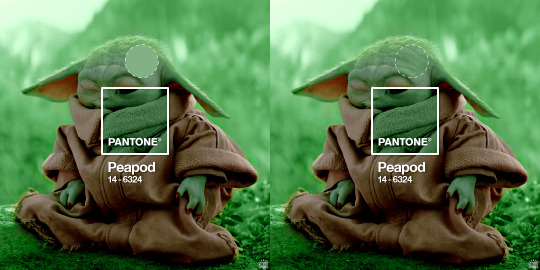
4.2 – Moving the base gif.
This isn’t really about coloring... but remember when I said to uncheck “Delete Cropped Pixels” in Step 2.1? Well, here’s your chance to adjust your canvas and move the gif around so the exact part you want under the color swatch is in the right position. I personally think these kinds of sets are more impactful when you put a differently colored part of your gif under the swatch so you can see through it and the difference is clearer. In my example, I put Grogu in the center so the green box would cover some of his brown potato sack robe.
4.3 – Color manipulation.
Color manipulation is when you transform your media’s original color grading into a completely different color. The Grogu gif isn’t a great example because the original scene was already a green-yellow color:
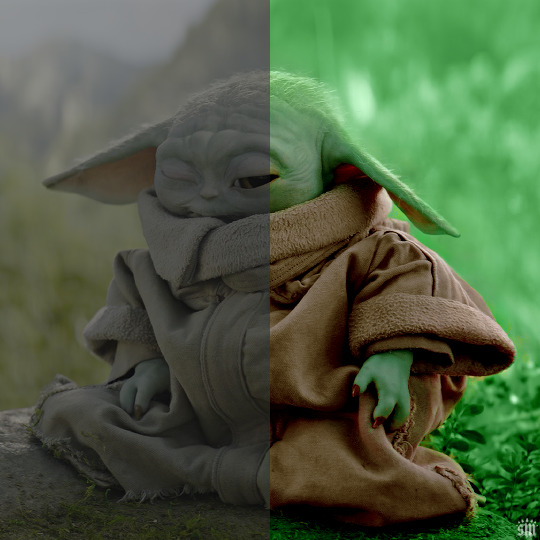
I mean, the difference is still pretty drastic but that’s mostly because my file was HDR and washed out as a result.
So, here’s an example I made using a gif from my first Pantone set for ITSV (I’m not doing this demo to the Grogu gif because it’d be too much work to manipulate a green background with a green subject. This ITSV scene is perfect bc the majority of it is blue while the subjects are mostly red.)

For the “basic coloring,” I did everything as I normally would: mostly levels and selective color layers.
For color manipulation, my fav adjustment layer is Hue/Saturation (those are the screenshots that are on the gif above). When you’re smart with your scene selection, it’s pretty easy to manipulate colors with one Hue/Sat layer because you usually only need to tamper with 1-2 colors and, hopefully, they shouldn’t interfere with skin tones (obviously you’ll do other layers to further enhance your gif’s brightness, contrast, etc. — but I just mean the heavy lifting usually only takes me one layer with a good scene choice).
All you have to do is figure out what color the majority of your gif is, toggle to that color’s channel, and fiddle with the hue slider. In the gif above, you can see that I played with both the Blue and Cyan channels. Here’s why:
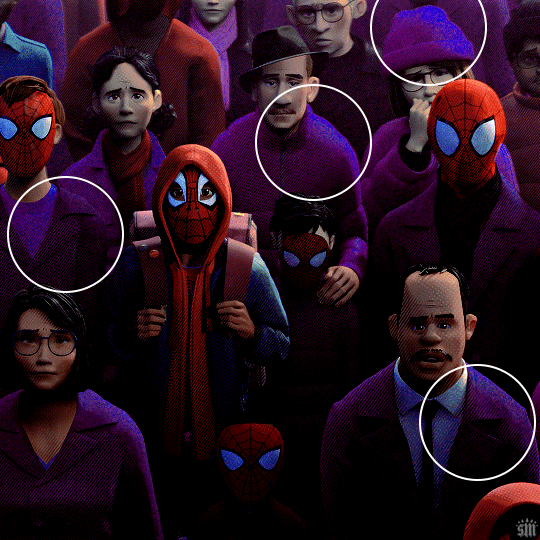
If I only adjust the Blue hue slider, I get those speckles of cyan peaking through in the gif above. Unless you’re working with completely flat colors — like 2D animation with zero shading/highlights — a color is never just one, solid color. Blue isn’t just blue, it may have some cyan. Purple isn’t just purple, I often have to toggle the Blue channel too. So, yeah, be mindful of that!
I’ll sometimes go in with the brush tool and paint over some areas of my gif to really smooth out the color and make it uniform. When I do that, I just set that painted layer to the Color blend mode. Some of the resources below go into that technique a bit more!
4.4 – Coloring resources.
While not all of these tutorials cover the same type of color manipulation I did in my gifs, I think the principles are similar and would be helpful to anyone who’s a beginner:
– color manipulation tutorial by usergif/me: I go a bit more in depth here (I think lol)
– how to change the background of any gif by usergif/fionagallaqher: a great tutorial for using keyframes so you can manipulate the background of a gif with lots of motion
– bea’s color isolation gif tutorial by nina-zcnik: this tutorial has more tips about hue/saturation layers as well as masking your subject
– elio’s colouring tutorial by djarin: this tutorial shows a lot of examples of first manipulating the colors then brushing over the gif with a matching color for extra coverage
And just one last note on coloring, I always try to appreciate gifs with the mentality that “good” coloring is 100% subjective. One of the only things I would classify as “bad” coloring is when you whitewash or [color]wash someone’s skin tone. So, as long as you keep the integrity of your subjects’ natural skin — especially if they’re a POC — you should feel good about your coloring, because it’s yours and you worked hard! <3
PHASE 4: EXPORT
That’s it!! If you work in Video Timeline like me, just convert from Timeline back to Frames, export your gif, and voila!
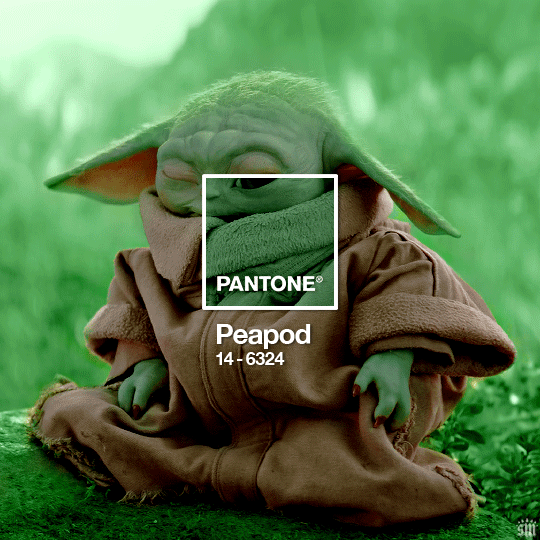
Easy PEAsy. 🥁
If you have specific questions about this tutorial, my ask box is open <3
Also, check out these other Pantone-inspired sets by my friends @nobodynocrime (Mulan set) and @wakandasforever (Ponyo set)! There are so many ways to use Pantone colors in your set, so I hope this inspires you to create something beautifully colorful <3
#gif tutorial#completeresources#usershreyu#useryoshi#userelio#userannalise#userzaynab#userives#usermarsy#usertreena#usercim#userrobin#userkosmos#usersalty#usermills#userhella#alielook#resource*#gfx*#pantone*
961 notes
·
View notes
Text
𝓢𝔀𝓮𝓮𝓽 𝓑𝓾𝓽 𝓟𝓼𝔂𝓬𝓱𝓸~ 𝓢𝓪𝓷'𝓼 𝓟𝓞𝓥

(♡´▽`♡)🔪🩸collab with @daesukiii. Read her part first here
(♡´▽`♡)🔪🩸Pairing: Choi San x Reader (f)
(♡´▽`♡)🔪🩸Genre: Horror, smut
(♡´▽`♡)🔪🩸Au: non-idol au
(♡´▽`♡)🔪🩸Trope: established relationship, yandere
(♡´▽`♡)🔪🩸Word Count: 1,275
(♡´▽`♡)🔪🩸Rating: 18+, MDNI
(♡´▽`♡)🔪🩸Warnings: ⚠️ yandere behavior ie sweet on the outside but would kill to protect their darling, violence, blood, death (a lot) ⚠️
(♡´▽`♡)🔪🩸Kinks: oral (f), strength kink, wall sex, glove kink, blood kink
(♡´▽`♡)🔪🩸Author's Note: this is dark, this is gritty, this is gorey, please be advised when you read this, it's really not for the faint of heart!!!
(♡´▽`♡)🔪🩸Banner by @daesukiii and divider cut from it

San should be focusing on the feeling of the once-hard skull feeling squishy in his hands but his anger burned too high for textile pleasures. Who did the waiter think he was to be even perceiving his darling? Let alone look down your shirt?! Your breasts, your body, YOU were his and only his.
“Why?” San said in a growl that lifted his lip in a sneer. “Don’t you have any manners? Or know better? Stupid little rabbits like you think they can nibble clover without watching out for the fox?”
San frowned slightly, sure he made a mess of his outfit. Did he have brain matter on him or was it just blood? Finding pieces of people he killed on him later was like finding food crumbs. Inconvenient at best.
Slowly, he ground the pulp that was once someone's head into the grating brick wall of the alleyway of the restaurant he had just finished eating at with you. His blood boiled to a loud rumble in his ears as he recalled how uncomfortable you looked discovering the waiter looking down your décolletage.
“Jokes on you, chump!” San giggled, high pitch and definitely off. “I’m the one who’s going for ice cream with her after. I’m the one taking her home and you’re never going home, are you?”
“San?”
Nothing draws his attention faster than your soft voice in his ears; his love, his life, his purpose on this earth. San shoved the body unceremoniously behind a dumpster, cleaning up and preparing for a more pleasant evening moving forward.
The next few days are stilted yet comfortable at the same time. San studied your movements, which were the same only tainted with a hesitance now that you had seen the side of him that loved you unconditionally. He didn’t understand why you were so afraid now.
It took him a few evenings to realize that you weren’t afraid of him; you were afraid of this new side of yourself that appreciated what he did for you.
It started with a test. San was used to your false friendliness with others. You did this to fit in, much like himself. But he watched with his Adam’s apple bobbing, as you flirted with the convenience store clerk. That one found an untimely death on the roof with a plastic bag over his head. A man who bumped into you when you walked in the park one afternoon hand in hand ended up fish food in the pretty pond in said park.
And every time he took care of the trash that dared bother you, he always made sure to kiss your temple and tell you he would love you forever.
One particular night, when he was sliding through the shadows along the hallway after killing a man who he had overheard speaking about your ass, he found your soft, perfect form was in a chair in the living room.
“San?” You called out with confidence that made San curious.
“Babe?” San straightened, automatically adjusting the gloves he ritually adorned before his kills.
“Don’t clean up just yet,” You demanded.
San tilted his head and smiled, his eyes disappearing in his adoration for you. “Of course, my love, whatever you desire.” He stood with his hands loosely in front of him, one hand on his wrist, awaiting further instructions.
“You didn’t give me a kiss yet. You always do when you get home.” You mentioned, a little too casually.
San, without hesitation, crossed the wooden floor with quick steps, to press his lips to yours. He could practically feel the vibrations of your shudder run through your body and into his lips. What did that shudder mean? San’s hands, still gloved, whispered over your robe and automatically stroked your spine. You practically melted against his jacket, as you usually did when he attacked your most vulnerable spot.
“Only my hands can touch you,” San murmured into your hair. Your scent enveloped him and he couldn't help but inhale deeply.
“San, do you truly love me that much?” The question comes from a different line of thought and he was pretty sure he knew what you were thinking. You are his darling, of course, he knows everything about you.
San pushed you back by grabbing both your upper arms and then moved his hands to cup your face instead. His thumbs stroked your cheeks, eyes almost teary-eyed in his insanity. He could never dwell on just how much he loved you otherwise he’d go over a cliff he could never come back from. You needed him so he could never entertain it, even though he was sure he would have some fun along the way.
There is blood on your robe, smeared along your face, and San thought perhaps you’ve never looked more beautiful than covered in the blood of the man who dared touch your privileged body. “If I can’t protect you, then what is my purpose?”
San watched as you fought with your logic and your beast. You knew what the wet substance was against your face and you knew what was on San. But when your tongue sneaked out subconsciously to catch the drop along the corner of your lip, San thought that he loved you even more than before. You were his to protect, his to twist, his to love forever.
“I love you,” You whispered and San’s heart dipped and soared.
San smiled through the tears that did actually fall down his cheeks. You, his beloved, his love, loved him. He knew you did, of course he did, but it never failed to knock him senseless when you said it. San peppered your face with kisses, sniffling and laughing, until he kissed your lips and you moaned into his mouth.
It wasn’t long before he pulled the knot to your robe to discover you had nothing underneath. With one gloved hand on the small of your back and the other cupping the back of your head, San had your back against the wall between the windows, making out with you and grinding his slacks against your bare cunt. San was fully clothed and you had your robe falling into the crook of your elbows, and he wouldn’t have had it any other way.
You whined against his mouth until he broke the kiss. “San, make love to me,” You pleaded.
San shook his head. “No, let me pray to you.”
San, with the help of you balancing back onto the wall, slid down your body so that your legs were over his shoulder as he braced his hands against the wallpaper. He had only the use of his mouth but it did not hinder his lips and teeth nipping and pulling at your lower lips.
Your hands dived into his hair, holding him against you, encouraging him to make love with his lips against yours. His tongue worked against you sloppily. At first, he was more in the mind set to sweep up as much of your wetness along his taste buds than give you pleasure. His muffled groan at the taste of you made you cry out in pleasure.
San brought you to completion as your thighs shook and he slurped up all the creamy goodness that came from your cunt. You breathed heavily above him and he let you slide down with him until both your asses were on the floor.
San leaned over, unhinged and unleashed, and licked your cheek, where the blood had been smeared against your face. “I love you, forever.”
You giggled, an edge to yours that San recognized, having balanced on the same knife’s edge of sanity. You were so perfectly his. “I love you too, Sannie.”
#yandere!san#ateez scenarios#choi san scenarios#choi san smut#ateez smut#choi san x reader#topaz's work#recent#ღatz#red string of fate collab 🧵
52 notes
·
View notes
Text
『 Dark If 』 Story Event: Premium END
Jude Jazza

This is a fan-made translation solely for entertainment purposes with no guaranteed perfection. I do not own any of the original content. Please support CYBIRD by buying their stories and playing their games. Reblogs appreciated.
❥・• Warnings and FAQ
Pretending to obediently stay in the palace, I explained the details of the curse to my father.
However, —
King: Are you saying that you have an illness and will die soon? There is no way I will believe such a ridiculous thing!
King: Poor girl… you must have been brainwashed by that wicked fairy.
Kate: No…! Please believe what I’m telling you…!
King: You are forbidden from leaving your room, until this mess is resolved. Do you understand me?
My father refused to believe my words, and locked my room door with multiple locks.
(This won't do… I need to escape this room and find a spinning wheel.)
Tying a few dresses from my closet together, I secured them to a pillar and opened my window.
…
Meanwhile—.
Inside a cell in the palace’s dungeons, the prisoner leisurely takes a few puffs on a cigarette, making the prison guard panic.
Warden: W-Where did you get a cigarette from… who lent you a fire to light that up!?
Guard: I- I didn't know he had a cigarette!
Jude: You’re making too much noise over a little cigarette.
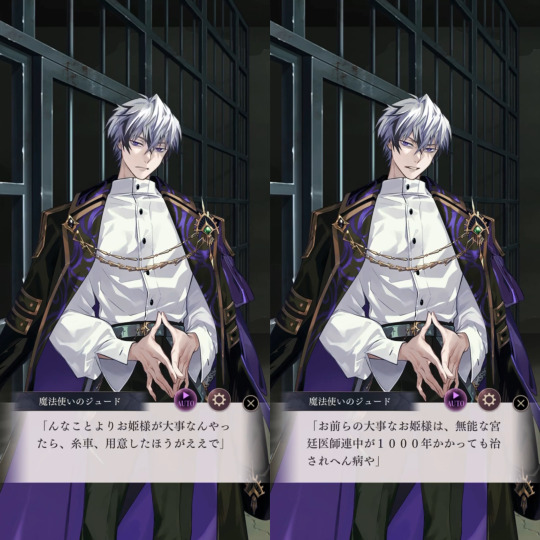
Jude: Instead of fretting about something this stupid, you’d best get a spinning wheel ready if you truly cherish your princess.
Guard: What are you talking about?
Jude: Your dear princess has an incurable illness that your incompetent royal doctors won’t be able to cure even in a thousand years.
Jude: Once her curse takes effect, time will stop for her body. During the time when she’s asleep, I’ll treat her illness.
Jude: I wanted to say the same thing 10 years ago, but those useless bastards refused to listen to me.
Warden: He’s merely spouting nonsense to save himself! Ignore him!
Jude: *sigh*...
Jude let out a deep sigh with some purple smoke and pressed his cigarette butt onto the cold prison floor.
Jude: All of you are asking to be beaten to a pulp.
…
Kate: This should be where the textile mill is located…
(It’s impossible for me to break into it with all these barbed wires.)
(I’ll be caught by the security if I enter through the main entrance… I don’t have time for that.)
Kate: At this rate, I’ll have to break my way through the barbed wires and end up covered in blood—
???: I didn’t think “Thorn Princess” referred to a princess torn to pieces by thorns.
Kate: …!?
I was startled by the sudden sound of someone’s voice, and turned around to see a man with mint-coloured eyes who seemed to have appeared out of nowhere.
Kate: W-Who are you…? If you’re one of my father’s acquaintances, I’ll have you know that I won’t be returning to the palace. Please, leave.
Fox: I’m merely a lying fox.

Fox: And I happen to know where to find what you're looking for. Now, am I lying or telling the truth?
Kate: …! How did you know what I'm looking for?
Fox: Who knows? Let me get this straight, you’re looking for a spinning wheel to prick yourself on its spindle so you can fall into a deep sleep.
Fox: When that happens… you won’t be able to return to your original world for the next 100 years.
Fox: If “that guy” fails to find a cure to your illness, you might even die in your sleep.
(This man… he seems to know everything about my situation.)
He could be a similar existence to Victor, the man I met before being transported into this fairytale world.
I looked directly into his mint-coloured eyes.
Kate: — Even so, that doesn't matter to me.
Kate: Because he’s only trying to keep our promise.
Fox: Hmm… then I shall take you to that thing you're looking for.
…
The fox guided me to a clock tower overlooking the whole country.
Kate: Jude…!?

Jude: Tch… why aren’t you in your room?
Kate: How did you escape from prison… or rather, how did you break into my room!?
Jude: Your palace is guarded by a bunch of monkeys with worms for brains. No wonder the princess who grew up there has absolutely zero crisis management skills.
Kate: What…? But, Mr Fox, I was looking for the spindle of a spinning wheel, not Jude—
Kate: … Huh? The fox isn’t here…
I looked back and realised that the man with mint-coloured eyes had vanished.
Jude: Talking about foxes and whatever, have you lost your mind?
Kate: N-No…!
Kate: After we were separated— I made a promise with you from the past.
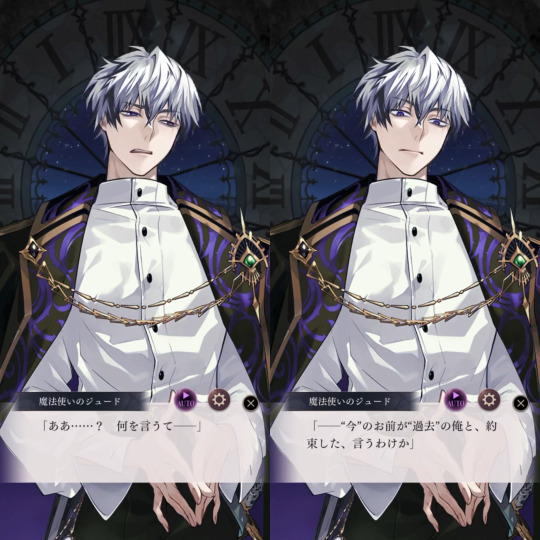
Jude: Ah…? What are you talking about—
Jude: — Are you saying that the present day “you” made a promise with “me” from the past?
Kate: It appears so… I don’t understand how I was transported into the past either.
Jude: If there’s magic that can stop time, perhaps there’s one for something like this too. I don't know for sure, though.
Jude muttered in a dismissive tone and frowned.
Jude: … I get it. I thought you’ve already forgotten about the promise.
(I thought I did, but…)
– Flashback Start –
Kate: You’re the fairy who cursed me, aren’t you?
Kate: I apologise for the sudden visit, but I’m here to speak with you in regards to lifting the curse.
Jude: … Ah?
– Flashback End –
(Could it be…)
Kate: By any chance, were you mean towards me at our first meeting because of that assumption?
Jude: I don’t remember things that happened a long time ago.
Jude: So now you know why you’re cursed?
Kate: Yes… and that’s why I’m looking for the spindle of a spinning wheel.
Jude: Then I have one here.
Kate: Wha… what!?
Jude pulled out a sharp needle from his pocket.
Kate: Why do you have that with you…?
Jude: Of course it’s to prick you with it.
Kate: I-Isn’t that too sharp to be a spinning wheel’s spindle…?
Jude: A blunt one would be useless.
Kate: I asked the same question to you from the past, but…
Jude: Tch… you have too many questions, young lady.
Kate: Why do I have to prick my finger on a spindle…?
Jude: Maybe it’s just the way you look, who knows. Besides— you seem to enjoy pain.
(... Ah, just as I expected.)
(That boy was indeed Jude.)
My chest felt warm.
It was as illogical as falling for the person who kidnapped you—
I was attracted to this man.
Both the “me” who came from London, and the “me” who lived in this world were.
Kate: … Please tell me one last thing.
Jude: It won't be the last. I said I won’t let you die.
Kate: Why are you doing so much to help me…?

Jude: …
Jude: Because I hate owing someone. It’s just in my nature.
(... I see.)
Kate: … Fufu, that’s so like you.
Jude: Ah, also…
Kate: …?
Jude: That day I met you in that back alley… you were the type of person to jump into trouble without thinking it through, then yell at some kid you just met.

Jude: Even though you spent your life confined in the palace and your life was hanging by a thread, you were a tough princess who knew to bite back.
Kate: … Are you mocking me…?
Jude: I’m praising you.
Jude: But — now I think about it, 100 years of my life isn’t going to come cheap.
Kate: Huh…?
Jude: Although both acts count as “saving a life”, you coincidentally being in that alley and saving me isn’t the same value as me spending 100 years to find you a cure for your illness.
(Did I unknowingly dig my own grave…?)
Jude: Let’s say what you did for me is worth only 50 years of my efforts—
Jude: After I successfully cure this illness of yours and you awaken from your sleep, I can use the remaining 50 years to conveniently have you do hard labour for me.
(—!)
Kate: Does that mean we’ll still be together after I wake up…?
Jude: Tch, you made that sound creepy.
Jude: Make sure you properly return the favour, got it?
Kate: Understood… I promise to compensate you in full for the 50 years!
I never expected myself to feel that happy before falling asleep due to my curse.
Kate: … Please go ahead and prick me.
I heard the soft rattling of the chains on his clothes—
The spindle slowly sank into my skin.
Kate: … nn… ugh…
Heat rose from the site where he pricked me, and gradually spread throughout my body.
The sensation was like being poisoned, and I felt a little afraid…
(Remember… this pain and curse are from Jude—)
Jude: … Feeling good?
Kate: …!?
I opened my eyes to see Jude laughing at me.
Jude: As expected, you do like pain. … You’re a nasty woman.
(Ah…)
I felt my consciousness slipping away.
It was as though I was slowly falling asleep, feeling slightly fatigued.
Kate: J-Jude…
Jude: — Good night, Princess.
After I heard his gentle voice, my consciousness faded into darkness.
And then — the time between losing consciousness and feeling a bright light shining on my face felt both instant and like forever at the same time.
…
I slowly opened my eyes.
I was in neither the clock tower nor the palace. Instead, I found myself in a quiet castle shrouded in thorns.
Ellis: … Ah, Jude, Kate is…
I looked in the direction of the approaching footsteps, and a man wearing a sadistic smile was looking down at me.
Jude: Awake at last, sleeping beauty?
Kate: … Am I dead?
Jude: What?
Kate: Because… 100 years should've gone by, but you and Ellis haven't aged into old men.
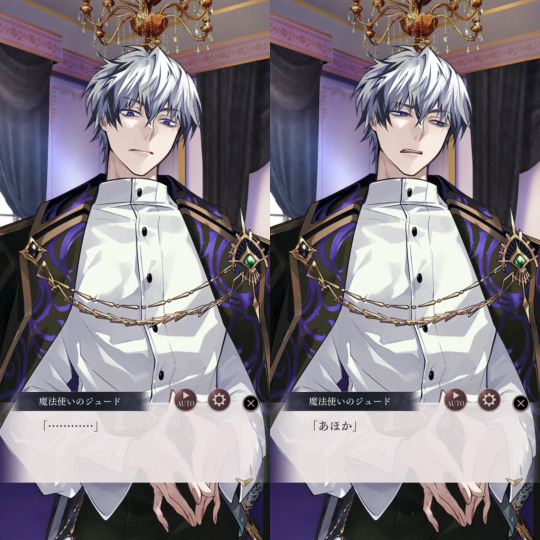
Jude: …
Jude: Stupid.
Ellis: Fairies have the ability to manipulate time, so they can also control the physical age of themselves and even other people.
Ellis: As long as they don’t get fatally injured, they won’t die from old age.
Jude: Did you learn nothing about fairies despite locking yourself in the library for days to study, idiot?
Kate: … What about my illness…?

Jude: I had 100 years, of course I cured it.
His triumph and haughty smile made my heart ache.
“I won’t ever break this promise, even in death.”
Since 100 years ago, I knew that he meant what he said.
Kate: Thank you, Jude.
Just like he did 100 years ago, Jude hooked a finger under my collar and pulled me closer.
Jude: I’ve done my part, now… time for your part of the debt to be paid.
Kate: Okay…!
The budding feelings of love I felt in my heart 100 years ago came back to me.
Aware of my growing feelings, I nodded enthusiastically.
I still didn't know what was missing from this twisted fairytale world, but…
(... If possible, I want it to remain undiscovered forever.)
Because, in this world, I had fallen in love with him.
— There was no returning to my original world.
80 notes
·
View notes